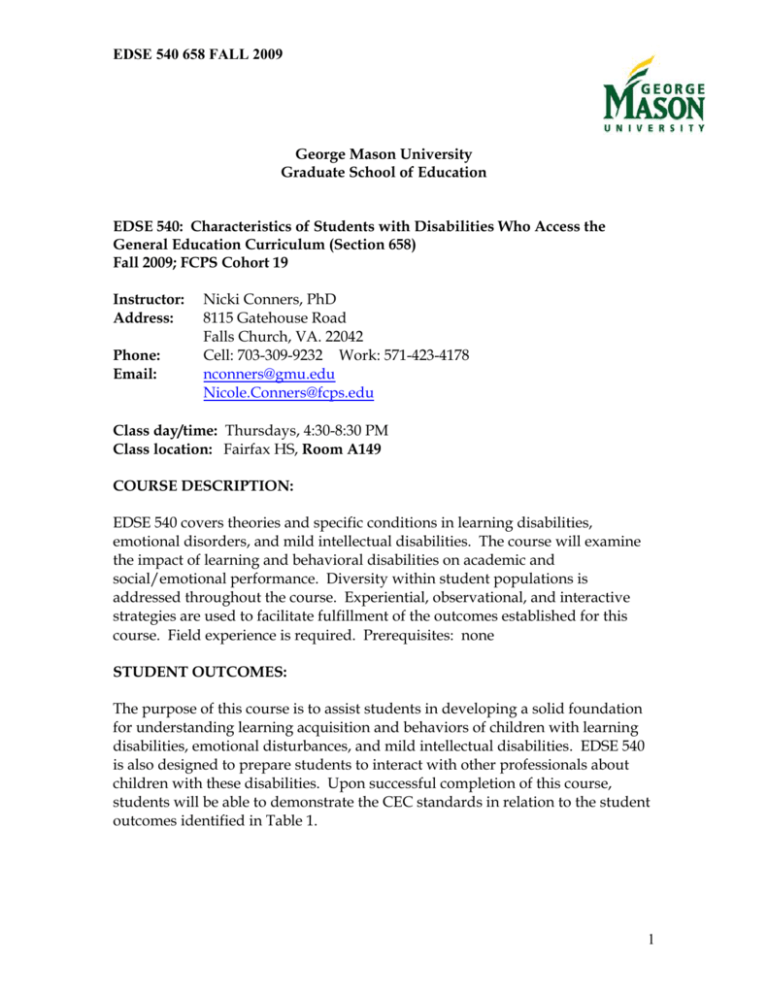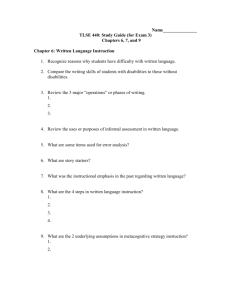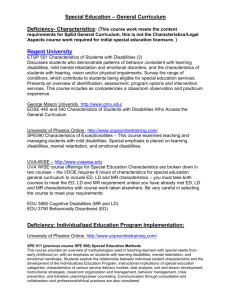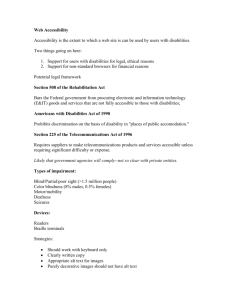EDSE 540: Characteristics of Students with Emotional Disturbance
advertisement

EDSE 540 658 FALL 2009 George Mason University Graduate School of Education EDSE 540: Characteristics of Students with Disabilities Who Access the General Education Curriculum (Section 658) Fall 2009; FCPS Cohort 19 Instructor: Address: Phone: Email: Nicki Conners, PhD 8115 Gatehouse Road Falls Church, VA. 22042 Cell: 703-309-9232 Work: 571-423-4178 nconners@gmu.edu Nicole.Conners@fcps.edu Class day/time: Thursdays, 4:30-8:30 PM Class location: Fairfax HS, Room A149 COURSE DESCRIPTION: EDSE 540 covers theories and specific conditions in learning disabilities, emotional disorders, and mild intellectual disabilities. The course will examine the impact of learning and behavioral disabilities on academic and social/emotional performance. Diversity within student populations is addressed throughout the course. Experiential, observational, and interactive strategies are used to facilitate fulfillment of the outcomes established for this course. Field experience is required. Prerequisites: none STUDENT OUTCOMES: The purpose of this course is to assist students in developing a solid foundation for understanding learning acquisition and behaviors of children with learning disabilities, emotional disturbances, and mild intellectual disabilities. EDSE 540 is also designed to prepare students to interact with other professionals about children with these disabilities. Upon successful completion of this course, students will be able to demonstrate the CEC standards in relation to the student outcomes identified in Table 1. 1 EDSE 540 658 FALL 2009 REQUIRED TEXT: Henley, Algozzine & Ramsey, Characteristics of and Strategies for Teaching Students with Mild Disabilities, 6th edition, ABLongman, ISBN 0205608388 NATURE OF COURSE DELIVERY: Class sessions may include a variety of formats and integrate instructional technology with lecture, discussion, guest presenters, video and small group activities. Students will be expected to engage in dialog with the instructor and peers cooperatively and collaboratively; mirroring their future roles as special educators. Alignment of Outcomes and Requirements with key CEC/NCATE Standards CEC/NCATE STANDARDS STUDENT OUTCOMES Standard 1: Foundations Special educators understand the field as an evolving and changing discipline based on philosophies, evidence-based principles and theories, relevant laws and policies, diverse and historical points of view, and human issues that have historically influenced and continue to influence the field of special education and the education and treatment of individuals with disabilities both in school and society. Standard 2: Development and Characteristics of Learners Special educators understand the similarities and differences in human development and the characteristics between and among individuals with and without exceptional learning needs (ELN). Special educators understand how exceptional conditions interact with the domains of human development and they use this knowledge to respond to varying Describe the field of learning disabilities from its origins to policies and practices of today. Compare the history of education for students with emotional and behavioral disorders, students with learning disabilities students with mild intellectual disabilities. Define learning disability, emotional disturbance, and mild intellectual disabilities. Describe how educators and other professionals determine the difference between normal and atypical behaviors. Describe COURSE REQUIREMENTS Reading assignments Small group discussion Journal abstracts Reading assignments Small group discussions Case Study 2 EDSE 540 658 FALL 2009 abilities and behaviors. Special educators understand how disabilities impact families, and the individual’s ability to learn, interact socially, and live as contributing community members. Standard 3: Individual Learning Differences Special educators understand the effects that an exceptional condition has on learning in school and throughout life. Special educators understand that beliefs, traditions, and values across and within cultures affect relationships among and between students, families, and school. Special educators seek to understand how primary language, culture, and familial backgrounds interact with the disability to affect academic and social abilities, attitudes, values, interests, and career options. Learning differences and their interactions are the basis for individualizing instruction to provide meaningful and challenging learning. characteristics of young children and adolescents with learning disabilities, emotional disturbances, and/or mild intellectual disabilities. Compare at least three conceptual models of behavioral deficits with three conceptual models that explain learning disabilities and/or mild intellectual disabilities. Discuss the various etiologies in relation to biological, family, cultural, and school perspectives. Identify various procedures and practices that motivate reluctant learners to complete class work and develop skills that build selfunderstanding and confidence as learners. Describe and discuss a range of learning disabilities, emotional disturbances, and mild intellectual disabilities for a parent and suggest possible interventions for home and school. Case study report Reading assignments Field Observations Final exam 3 EDSE 540 658 FALL 2009 Standard 6: Language Special educators understand typical and atypical language development and the ways in which disabilities can interact with an individual’s experience with and use of language. Standard 8: Assessment Assessment is integral to the decision-making and teaching of special educators and special educators use multiple types of assessment information for a variety of educational decisions. Special educators use the results of assessments to help identify exceptional learning needs and to develop and implement individualized instructional programs, as well as to adjust instruction in response to ongoing learning progress. Describe at least one theory of how children develop language.* Describe informal assessment procedures for determining knowledge and skills of children with various learning disabilities and emotional/behavioral problems. Based on informal assessment procedures, design appropriate clinical teaching strategies for children with various learning disabilities and/or behavior problems. Describe what an Individualized Education Program (IEP) is and how it is developed. Small group discussion Class activities Final exam Small group discussion Class activities Case study report Journal Abstracts Student presentation Final exam CLASS EXPECTATIONS: Attendance: Students are expected to (a) attend all classes during the course, (b) arrive on time, (c) stay for the duration of the class time and (d) complete all assignments to earn the 10 point class participation grade for each class. Attendance, timeliness, and professionally relevant, active participation are expected. Attendance and professional participation at all sessions is very important because many of the activities in class are planned in such a way that they cannot necessarily be recreated outside of 4 EDSE 540 658 FALL 2009 the class session. Please notify me in advance by phone or email if you will not be able to attend class. Workload: In-depth reading, study, and work on course requirements require outside class time. Students are expected to allot class study and preparation time weekly in addition to time spent on papers and assignments. Written and Oral Language: APA Style is the standard format for any written work in the College of Education. If you are unfamiliar with APA, it would benefit you to purchase the Publication Manual of the American Psychological Association (6th ed.) You are required to use APA guidelines for all course assignments. This website links to APA format guidelines: http://apastyle.apa.org We will use person-first language in our class discussions and written assignments (and ideally in our professional practice). We will also strive to replace the term “Mental Retardation” with “Intellectual Disabilities” in our oral and written communication in accordance with terminology choices in the disability community. Academic Integrity: Students in this course are expected to exhibit academic integrity at all times. Be aware that plagiarism is presenting someone else's work as your own. Whether the act is deliberate or unintentional is irrelevant. You must take great care to give credit to an author when you borrow either exact words or ideas. Generally, if you use 4 or more words in a row you should use quotation marks and a proper APA citation. Remember that plagiarism is a very serious offense and can result in dismissal from the University. Evidence of plagiarism or any other form of cheating in the class will result in a zero on that assignment and a report of the incident to the Dean’s Office. Email: Please note that your GMU email will be used often by GMU while you are a student. It is very important for you to set up your GMU email account. Please activate and forward your gmu email to your mostchecked account! Be an Informed Student: Negotiating all the requirements for your Master’s and/or VA Licensure is extremely complex. It is recommended that you schedule a phone/email or in-person appointment with the Special Education Advisor, Jancy Templeton (jtemple1@gmu.edu 703/993-2387). Doing so each semester will ensure that you rectify any 5 EDSE 540 658 FALL 2009 outstanding issues, are timely with all necessary paperwork, and are ultimately in good standing to graduate on time. Students are expected to exhibit professional behavior and dispositions. See http://gse.gmu.edu for a listing of these dispositions. Students must follow the guidelines of the University Honor Code. See http://www.gmu.edu/catalog/apolicies/#TOC_H12 for the full honor code. Students must agree to abide by the university policy for Responsible Use of Computing. See http://mail.gmu.edu and click on Responsible Use of Computing at the bottom of the screen. Students with disabilities who seek accommodations in a course must be registered with the GMU Office of Disability Services (ODS) and inform the instructor, in writing at the beginning of the course. See www.gmu.edu/student/drc or call 703-993-2474 to access the ODS. EVALUATION POINTS 100 points 100 points 50 points 60 points 50 points Class Participation (attendance and in class) Case Study Paper* Case Studies & Reflections (replaces class 10/15) Journal Summaries Paper Final Exam TOTAL POINTS: 360 points *This assignment is the “signature” assignment for the student portfolio It is recommended that students retain copies of all course products to document their progress through the GMU Special Education program. Products from this class can become part of your individual professional portfolio used in your portfolio classes to document your satisfactory progress through the GMU program and the CEC performance based standards. GRADING CRITERIA 95-100% = A 90-94% = A85-89% = B 80-84% = B70-79% = C < 70% = F 6 EDSE 540 658 FALL 2009 MAJOR COURSE ASSIGNMENTS 100 points: Class Attendance and Participation (10 points each class) Completion of weekly class activities, participation in class discussions, and project presentation update discussions throughout the semester. Points missed due to absences can not be made up. Excessive absences can result in additional penalties and potential withdrawal from class. 50 points: Case Studies for October 15th class **NO CLASS MEETING on 10/15/09 Due Date: 10/22/09 Each class member is expected to complete two out of three case studies for class assignment replacing a class meeting on Thursday, October 15th, 2009. 100 points: Case Study Report (100 points) Due Date: 11/5/09 A comprehensive case study on a student with emotional disability, learning disability, intellectual disability, or autism will be completed. MODEL PAPERS WILL BE PROVIDED. The case study should include the following components: Student’s demographic data (Draft 10/8) Description of school and student’s community (Draft 10/8) Educational history (schools attended, reason for referral, prereferral interventions, results of multidisciplinary evaluation, special education classification, description and location of educational service provision, related services) (Draft 10/8) Educational goals and objectives, classroom accommodations (Draft 10/8) Observational information (at least two class periods of observations specifically related to student goals, objectives, and accommodations) (Draft 10/22 ) Parent interviews (related to education goals, objectives, accommodations, and any other relevant issues.) (draft 10/22) Additional recommendations, educational accommodations, and/or modifications (draft 10/22) Summary and synthesis (comparison of student’s characteristics with those described in the textbook or other research, i.e., Which characteristics were identified in your student? Integrate at least three (3) sources from the literature with what you observed in your case study.) (draft 10/22) 7 EDSE 540 658 FALL 2009 Appendices – to include student work samples, parent interview questions/answers. (draft 10/22) CASE STUDY IS DUE 11/5/2009. Be prepared to present your case study in class orally on 11/12 OR 11/19. 60 points: Abstracts of Journal Articles (60 points) Due Date: 11/19/09 Each student will summarize three (3) journal articles that are relevant to the needs of the student chosen for the case study. Papers chosen for this requirement must be from peer-reviewed published journals (no ERIC documents!) and should be data-based examinations of issues relevant to the ED / LD field. Appropriate sources for journal articles include: Exceptional Children, The Journal of Learning Disabilities, Learning Disabilities Quarterly, The Journal of Special Education, Learning Disabilities Research and Practice, Remedial and Special Education, Journal of Emotional and Behavioral Disorders, etc… The purpose of this assignment is twofold: first to identify research-based findings that are relevant to the needs of your case study student and second, to distill the major points of the article to a one-page summary. The abstract should be typed and include an introduction to the students needs, followed by 3 summaries with an APA style citation at the top of the page. Each entry should consist of two parts labeled 1.-Summary and 2.-Critique. Finally, a conclusion that ties together the 3 summaries’ findings should be presented as an action plan for assisting the student to meet an identified need. MODEL PAPERS WILL BE PROVIDED. All articles should be from current literature and should not be more that five (5)) years old. You must use your own words to summarize. 50 points: Take Home Final Exam (50 points) Due Date: 11/12/09 An exam that covers course content will be provided as a take home examination. The exam will be based on case studies and other class related topics. It will be provided on the second night of class and you may choose to work on it throughout the semester as information is shared and discussed. 8 EDSE 540 658 FALL 2009 Course Calendar (subject to change based on class needs) Class Thursday, September 17th (1) Topics Registration, Introductions, and Backgrounds Assignments Chapter 1& 2 Due This Class Session N/A Cohort Structure and Questions Syllabus Review (Education Library) Thursday, September 24th (2) Thursday, October 1st (3) Thursday, October 8th (4) Context of Special Education Introduction Overview of Students with Mild Disabilities Instructor will set up a BB site for the course. Students with Learning Disabilities Chapter 5 Students with Learning Disabilities, cont. Chapter 7 & 10 Students with Disabilities: Access to the Curriculum, Accommodations, Modifications Read Chapters 1 and 2 Read Chapter 5 Please select the student that you will use for the case study by this date. Read Chapters 7 & 10 First four sections of DRAFT case study paper DUE: -Student Demographics -Description of School and Neighborhood -Student’s Educational History -Student’s Current Areas of Need Guest Speaker TBD Instruction 9 EDSE 540 658 FALL 2009 Thursday, October 15th (5) Thursday, October 22nd (6) NO CLASS MEETING TONIGHT Out of Class Assignment: Case Studies—choose two out of three case studies to read and answer questions. Students with Emotional Disabilities Chapters 4 & 9 Guest Speaker TBD (7) Students with Mild Intellectual Disabilities Read Chapters 4 and 9 Case Studies DUE (from last week) Classroom Management Thursday, October 29th Case Studies DUE NEXT WEEK Chapter 3 & 8 Last sections of DRAFT case study paper DUE:: -Observations -Parent Interview Summary -Student Interview Summary -Instructional Recommendations -So What -Summary and Synthesis of Case Study -References -Appendices Read Chapters 3 & 8 Guest Speaker TBD Thursday, November 5th (8) Students with High Functioning Autism Chapters 6 & 7 CASE STUDY PAPER DUE Read Chapters 6 & 7 Writing Effective IEPs and Educational Reports Thursday, November 12th (9) Co-teaching Collaboration and Inclusive Practices BEGIN Case Study Presentations Chapters 6 & 11 BEGIN case study presentations Read Chapters 6 & 11 Start Case Study Presentations TAKE HOME FINAL EXAM DUE NO LATER THAN by 11:30 PM TONIGHT 10 EDSE 540 658 FALL 2009 Thursday, November 19th (10) Case Study Presentations Building Family Partnerships Prepare for case study presentations Finish Case Study Presentations Course Evaluations JOURNAL SUMMARIES PAPER DUE **SCORING RUBRICS FOR CASE STUDY AND JOURNAL ABSTRACTS ASSIGNMENTS PLUS MODEL PAPERS FOR EACH ASSIGNMENT WILL BE PROVIDED AT A LATER DATE** 11 EDSE 540 658 FALL 2009 Case Study Assignment Case Study Points Possible (100) Writing Style Mechanics/APA 10 points Student Demographic Information 10 points Description of School and Neighborhood 10 points Educational History 10 points IEP Goals and Objectives 10 points Parent Interviews 10 points Instructional Recommendations 10 points Summary and Synthesis 10 points Observational Information/Appendices (student work, etc…) 10 points Presentation of Case Study 10 points TOTAL POINTS _______/100 POINTS Points Received COMMENTS: 12 EDSE 540 658 FALL 2009 Journal Abstracts Scoring Rubric Journal Abstracts Points Possible (60) Writing Style/Quality Mechanics/APA 5 points Introduction to Student’s Needs (based on your case study) 5 points Quality of Summaries 20 points Quality of Critiques 20 points Points Received Conclusion/Appropriateness of Recommendations 10 points TOTAL POINTS _______/60 POINTS COMMENTS: 13








